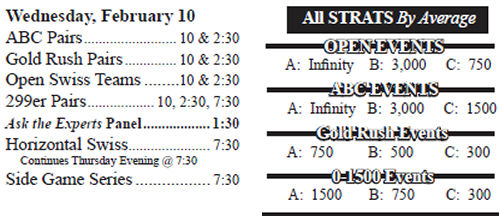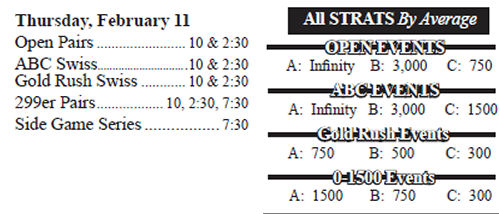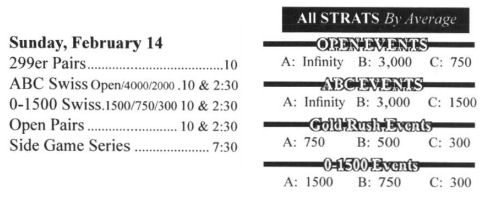

At some point almost every serious bridge player wonders about how the schedules for Regional Tournaments are determined. This document will attempt to clarify the process.
In District 25 the schedule for each tournament is drawn up by the Tournament Committee, a group of volunteers that works hard to devise a schedule that will provide a positive experience for the largest number of participants. This schedule must then be approved by the Executive Committee, which includes representatives from each unit.
The schedule must meet certain guidelines established by the ACBL. These guidelines use two terms that might be somewhat confusing to the average player: flights and strats. These concepts are probably best illustrated with an example. Here is the schedule for the first day of the 2016 Regional Tournament in Cromwell and the table of strats.

A strat (in bridge circles “stratum” is seldom used) is a level in an event used for scoring, not for eligibility of participation. The scores in stratified events are based upon masterpoints. The stratification can be based upon the player with the most points or upon the average of the team members (or pair in a pairs game). The ACBL has published guidelines for all kinds of events. Although these guidelines are not mandatory, they were used without modification for the tournament cited above. In District 25 stratification is usually based upon the average of the team members or pair.
So, the Gold Rush Pairs event has three strats: 0-299.99, 0-499.99, and 0-749.99. Pairs with an average of under 300 points can win the top strat, but they must do better than the players with over 500 points. However, to win the bottom strat they must only score more than the other pairs with average points under 300. This approach allows players with less experience to play against players with more points but to be scored against their peers. It is not perfect, but it does address the frustration of players who must compete against others with far more experience.
Similarly, the ABC Pairs event also has three strats. The breaking points are 3,000 and 1,500 masterpoints. The Open Swiss Teams, which is scheduled at the same times, also has three strats, but the breaking points are 3,000 and 750. In all of these the averages are used for stratification.
Why would the Swiss and the Pairs have different strats when they are both open events and occur at the same times? The reason is that the ACBL considers the pairs events as two flights of the same event. This has two important ramifications. In the first place, it makes the pairs event a much larger event that awards a much larger number of masterpoints. In effect, the winners in the ABC Pairs event are given credit for finishing ahead of everyone in the Gold Rush event! Of course, those who do not place win nothing. Secondly, the ACBL recommends a higher level for the lowest strat so that players who are no longer allowed to compete in the Gold Rush event because they have exceeded the 750-point maximum can be scored with others in the same position.
The same line of reasoning applies to the team events. Below is Thursday’s schedule.

Note that in this case the ABC Swiss uses the 3,000 and 1,500 breakpoints, while the Open Pairs uses 3,000 and 750. This is because the Swiss event is considered to comprise two flights, but the pairs event only one.
The 299er Games and Side Games are also stratified. In District 25 the levels are usually set by the director.
The Sunday schedule for Cromwell features an unusual flighted Swiss.

Teams with any player with more than 1500 points will not be allowed to play in the 0-1500 Swiss. They must play in the ABC Swiss. As in all of the other events the stratification will be based on the average masterpoints of the team members. The objective is to provide a Swiss event in which the players who have exceeded the 750-point limit of the popular Gold Rush will not be required to play against the most experienced players.
For 2016 the ACBL has approved an experimental use of three-flighted events. It will be employed for three days at the tournament in Nashua. Here is how that approach would work for pairs:
• The Gold Rush pairs would have only two strats. The recommended breaking point would be at 500 masterpoints.
• The middle flight of pairs would be limited to players with less than 2,500 masterpoints. It would also have two strats with a breaking point at 1,250 masterpoints.
• The top flight of pairs would have a breaking point of 4,000 masterpoints.
• Other events held at the same time would not be affected. If an Open Swiss was also scheduled, it would be considered a one-flight event with the usual strats. If the three-flighted event was a Swiss, the Open Pairs event would have one flight.
If you hear players using the term “2-2-2,” they are probably referring to this arrangement. It means that there are three flights of two strats each. None of these events is scheduled for Cromwell, but this format will be used extensively in Nashua, Warwick, and Mansfied.
